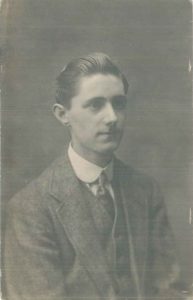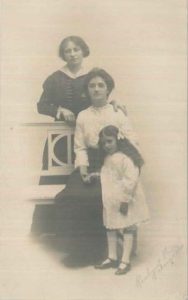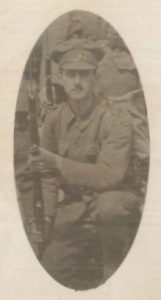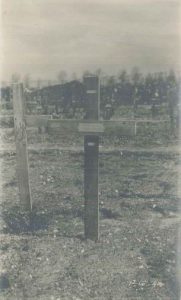Follow the Drum: Families at War
Archive material in the Local Studies collections provides an authentic glimpse into the experiences of families in the borough who had loved ones that were away from home, involved in the fighting. The stark realities of some of the experiences are both direct and moving. We hold a range of wonderful photographs, letters, albums and writings which can be accessed by the public. Documents such as these are unique and of historical importance. They also reveal moving stories of individuals and families with their insights into the war. It is also possible to research the context for key events by using original maps, directories, archived electoral registers, newspapers and cuttings.
Doggie’s’ story
 The Alfred W. Richardson collection consists of letters, photographs, drawings and more and was deposited with us by one of our customers. From these letters we see WWI from the perspective of a young man stationed in France and a his family at home in Richmond upon Thames.
The Alfred W. Richardson collection consists of letters, photographs, drawings and more and was deposited with us by one of our customers. From these letters we see WWI from the perspective of a young man stationed in France and a his family at home in Richmond upon Thames.
An only son with a younger sister, Alfred W. Richardson always affectionately signed his correspondence either ‘Dog’ or ‘Doggie’. His profound love for his father, mother and sister is glaringly obvious when reading his letters home. He was just starting to shoulder certain family concerns and due to his father’s illness and consequent lack of employment he was deeply concerned for his mother and all the family. A level of great maturity can be seen developing across letters to them all.
On many occasions he tries to shelter them from the harsh realities of the fighting that he was engaged in and the degree of threat to his own life. Doggie would allude to action by saying: ‘we have been busy’. He was also fun-loving. He mentions writing to and waiting to hear from a girl called Verity. However he also rebuffs his father’s efforts to get him to contact some girls at home. He asks for cigarettes from home like any other young man of his age at that time.
A close-knit family
Born on the 19th March 1894 to Alfred W. Richardson (Senior) and his mother Elizabeth née Jackman, he is recorded in the 1911 Census as living on Newry Road, St Margarets. The Census also lists his sister Violet Jackman Richardson and his maternal Grandmother Ann Jackman altogether with them in the same household.
Alfred attended Richmond Parochial School and later worked as a Solicitor’s Junior Clerk. Upon war being declared he became a Civil Service Rifleman with the 13th London Regiment. He wrote numerous letters and postcards to his mother mainly but also to his father, sister (addressed as ‘Little Vi’) and some other extended family members.
 Alfred was always ‘Darling Doggie’ to his mother, and he signed his letters to her with anything up to 20 kisses at the bottom. They were best friends:
Alfred was always ‘Darling Doggie’ to his mother, and he signed his letters to her with anything up to 20 kisses at the bottom. They were best friends:
My Darling Mother,
We go to the trenches again tomorrow for 3 days, and from there we are going on a long march somewhere, so you must not worry if you do not hear from me for three or four days’.
DC 23/1/1/19 (15th August 1916).
It is possible to gain an insight into the social history at that time for that family. Due to illness his father recuperated at the seaside and was unemployed. How did Elizabeth manage, raising Vi on her own, with no bread-winner and her eldest boy away in the army?
Encountering Doggie

This unique collection also includes photographs, letters from the Chaplain and from his Nurse concerning his hospital treatment for his wound in Rouen, France and subsequent death. There are also some official records and documents reflecting key events in his life. Doggie’s style is modest, under-stated and restrained. This personal correspondence is a valuable historical record. For example, we can see the officers’ signatures/stamps for censoring the mail.
We can also encounter Doggie through his love of nature, botany and art. Included in the collection are some pressed flowers, gathered in April 1916 and a lovely hand drawn picture of some blooms signed with his initials. His training and active service took him to Winchester, Le Havre and Rouen. There are post-cards of North Africa which may also indicate other experience abroad. Like so many other young men his age this was likely to be his first time abroad, away from home.
Dog faced harrowing conditions which he only hints at in his writings. He had a real and profound faith which ultimately sustained him. The young boy from Richmond Parish Sunday School obtained Certificates in Bible Studies. Not long after those successes, as a young soldier he requested his own personal Bible be sent out from home to him at the front (at least twice in August 1916 when writing to his mother just one month before he died of wounds in September).
Final days
The day he was wounded (7th September 1916) found him writing to his mother:
Well dearest I … hope everything will be settled before long and that we can all come home again. DC 23 1/1/23
 This was his last letter to his mother. The wound was so serious that he was taken to No. 3 Stationary Hospital, Rouen. Doggie was moved on the 12th September 1916. It was his nurse, Dorothy Chapman who wrote sympathetically to his mother from there, alerting Elizabeth to the gravity of the situation. Dorothy references ‘a nasty wound in the right thigh’. She also commends his courage:
This was his last letter to his mother. The wound was so serious that he was taken to No. 3 Stationary Hospital, Rouen. Doggie was moved on the 12th September 1916. It was his nurse, Dorothy Chapman who wrote sympathetically to his mother from there, alerting Elizabeth to the gravity of the situation. Dorothy references ‘a nasty wound in the right thigh’. She also commends his courage:
I should like to say from myself that his pluck is simply splendid – he is so good and patient. He wants me to send you and his Dad his best love, and also his little sister.
Alfred died of his wounds on September 15 1916, aged 22.
Encountering Doggie can be a source of inspiration despite the personal tragedy. It is possible to share his experiences through his own words and thus there is no hint of glamour: simply raw honesty from a brave person.
Doggie’s final resting place is in the St Sever Cemetery in Rouen.
Following the turmoil of the war period the family chose the verse below as an inscription for the headstone that was finally in place to mark Alfred’s grave in France:
‘Farewell beloved so young & brave thy last “roll call” is o’er. Mother.’
![]()
This blog article is based on the presentation given by Patricia Moloney (Local Studies Assistant) at The National Archives (22nd September 2017) illustrating local life stories from the First World War. Patricia also gave a workshop covering this material at Richmond upon Thames Local Studies Library & Archive (28th September 2017).
For more blog posts about life in Richmond upon Thames during WWI Follow the Drum
Bibliography
The Alfred W Richardson Collection DC 23
[Patricia Moloney Local Studies Assistant]
